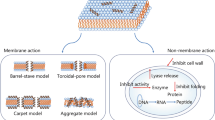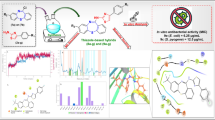Abstract
A series of ciprofloxacin/thiazolidine-2,4-dione hybrids 3a-m were prepared and identified by IR, 1HNMR, 13CNMR and elemental analysis. The antibacterial activity results of the designed hybrids revealed a shift of spectrum toward Gram-positive bacteria. They exhibited excellent activity against S. aureus ATCC 6538, with the most potent compounds being 3a, 3e, 3g, 3i, 3k, 3l and 3m possessing MICs of 0.02, 2.03, 0.64, 0.35, 1.04, 0.22 and 0.36 µM, respectively, compared to their parent compound ciprofloxacin (MIC: 5.49 µM). They also showed interesting activity against MRSA AUMC 261 with 3a, 3e and 3l showing MIC values of 5 nM. Reduced activity was observed against Gram-negative bacteria with compound 3l exhibiting a slightly higher activity against K. pneumoniae ATCC10031 with a MIC value of 0. 08 µM. Mechanistically, the incorporation of thiazolidine-2,4-dione ring into ciprofloxacin retained its ability to inhibit DNA synthesis via inhibiting both topoisomerase IV and DNA gyrase of S. aureus. Compounds 3a, 3l and 3m were more potent than ciprofloxacin for topoisomerase IV (IC50 = 0.3–1.9 μM) and gyrase (IC50 = 0.22–0.31 µM) inhibition, which coincide with their antibacterial activity against S. aureus ATCC 6538. Docking against DNA gyrase active site confirmed the ability of the tested compounds to form stable complexes with the enzyme; like that of ciprofloxacin, 3a, 3i, 3k, 3m and 3l reconsidered promising broad-spectrum antibacterial agents targeting topoisomerase IV and gyrase enzymes and have good activity against MRSA.
Graphic Abstract










Similar content being viewed by others
References
Hopeer DC (2001) Emerging mechanisms of fluoroquinolones resistance. Emerg Infect Dis 7 (2): 337–341. https://www.ncbi.nlm.nih.gov/pmc/articles/PMC2631735
Bisacchi GS (2015) Origins of the quinolone class of antibacterials: an expanded “discovery story” miniperspective. J Med Chem 58: 4874–4882. https://pubs.acs.org/doi/abs/https://doi.org/10.1021/jm501881c
Redgrave LS, Sutton SB, Webber MA, Piddock LJV (2014) Fluoroquinolone resistance: mechanisms, impact on bacteria and role in evolutionary success. Trends Microbio 22: 438–445. https://www.sciencedirect.com/science/article/abs/pii/ S0966842X14000894
Anderson VE, sheriff NO (2001) Type II topoisomerase as targets for quinolone antibacterials: turning Dr. Jekyll into Mr. Hyde. Curr Pharm Des 7: 337–35. https://www.ingentaconnect.com/content/ben/cpd/2001/00000007/00000005/art00003
Champoux JJ (2001) DNA topoisomerases: structure, function and mechanism. Ann Rev Biochem 70: 369–413. https://www.annualreviews.org/doi/abs/ 10.1146/
Drlica K, Malik M, Kerns R J, Zhao X (2008) Quinolones mediated bacterial death. Antimicrob Agents Chemother 52: 385–392. https://aac.asm.org/content/52/2/385
Aubry A, Pan XS, Fisher LM, Jarlier V, Cambau E (2004) Mycobacterium tuberculosis DNA gyrase: interaction with quinolones and correlation with antimycobacterial drug activity. Antimicrob Agents Chemother 48: 1281–1288. https://pubmed.ncbi.nlm.nih.gov/15047530
Finch RG (1995) The role of new quinolones in the treatment of respiratory tract infections. Drugs 49(2): 144–151. https://link.springer.com/article/https://doi.org/10.2165/00003495-199500492-00024
Gillespie SH, Crook AM, Mchugh TD, Mendel CM, Meredith SK, Murray SR, Nunn AJ (2014) Four- month moxifloxacin-based regimens for drug- sensitive tuberculosis. New Eng J Med 371: 1577–1587. https://www.nejm.Org /doi/full/https://doi.org/10.1056/NEJMoa1407426
Aziz HA, Mustafa GAI, Abbas SH, Hauk G, Krishna VS, Sriram D, Berger JM, Abuo-Rahma GEDA (2019) New fluoroquinolone/nitric oxide donor hybrids: design, synthesis and antitubercular activity. Med Chem Res 28: 1272–1283. https://link.springer.com/article/https://doi.org/10.1007/s00044-019-02372-y
Khan KM, Siddiqui R, Ambreen N, Sultana N, Tauseef S, Ahmad A, Parveen S (2012) Synthesis, antibacterial and antifungal evaluation of norfloxacin derivatives. J Pharm Res 5: 666. https://www.researchgate.net/profile/Saima-Tauseef/publication/225082056
Dey R, Bishayi B (2020) Dexamethasone along with ciprofloxacin modulates S. aureus induced microglial inflammation via glucocorticoid (GC)-GC receptor-mediated pathway. Micro Pathog 145: 104227. https://www.sciencedirect.com/science /article/ abs/pii/S0882401020305143
Pudlo M, Luzet V, Ismaili L, Tomassoli I, Iutzeler A, Refouvelet B (2014) Quinolone–benzyl piperidine derivatives as novel acetylcholinesterase inhibitor and antioxidant hybrids for Alzheimer Disease. Bioorg Med Chem 22(8): 2496–2507. https://www.sciencedirect.com/science/article/abs/pii/S0968089614001527
Li J, Li S, Bai C, Liu H, Gramatica P (2013) Structural requirements of 3-carboxyl-4 (1H)-quinolones as potential antimalarials from 2D and 3D QSAR analysis. J Mol Graph Model 44: 266. https://pubmed.ncbi.nlm.nih.gov/23911994/
Daneshtalab M, Ahmed A (2011) Non classical biological activities of quinolones derivatives. J Pharm Pharm Sci 15(1): 5272. https://journals.libraryualberta.ca/jpps/index.php/jpps/article/view/12211
Mohamed HHH, Abbas SH, Hayallah AM, Abuo-Rahma GEDA, Mostafa YA (2020) Novel urea linked ciprofloxacin-chalcone hybrids having antiproliferative, topoisomerases I/II inhibitory activities and caspases-mediated apoptosis. Bioorg Chem 106: 104422. https://www.sciencedirect.com/science/article/abs/pii/ S0045206 82031720X
Hu YO, Zhang S, Xu Z, Lv ZS, Liu ML, Feng LS (2017) 4-Quinolone hybrids and their antibacterial activities. Eur J Med Chem 141: 335. https://www.sciencedirect .com/science/article/abs/pii/S022352341730765
Fedorowicz J, Sączewski J (2018) Modifications of quinolones and fluoroquinolones: hybrid compounds and dual-action molecules Monatsheft efür Chemie-Chemical Monthly 149(7): 1199–1245. https://link.springer.com/article/https://doi.org/10.1007/s00706-018-2215-x
Abuo-Rahma GEDA, Sarhan HA, Gad GA(2009) Design, synthesis, antibacterial activity and physiochemical parameters of novel N-4-piperazinyl derivatives of norfloxacin. Bioorg Med Chem 17: 3879–3886. https://www.sciencedirect.com/science/article/abs/pii/S0968089609003873
Mohammed HHH, Abdelhafez ESMN, Abbas SH, Moustafa GAI, Hauk G, Berger JM, Mitarai S, Arai M, Abd-El baky RM, Abuo-Rahma GEDA (2019) Design, synthesis and molecular docking of new N-4-piperazinyl ciprofloxacin-triazole hybrids with potential antimicrobial activity. Bio Org Chem 88: 102952. https://www.sciencedirect.com/science/article/abs/pii/S0045206818308988
Aziz HA, Moustafa GAI, Abuo-Rahma GEDA, Rabea SM, Hauk G, Krishna VS, Sriram D, Berger JM, Abbas SH (2020) Synthesis and antimicrobial evaluation of new nitric oxide-donating fluoroquinolone/oxime hybrids. Arch Der Pharm 2000180. https://onlinelibrary.wiley.com/doi/full/https://doi.org/10.1002/ardp.202000180
Sriram D, Aubry A, Yogeeswari P, Fisher LM (2006) Gatifloxacin derivatives: synthesis, antimycobacterial activities and inhibition of Mycobacterium tuberculosis DNA gyrase. Biorg Med Chem lett 16: 2982–2885. https://www.sciencedirect. com/science/article/abs/pii/S0960894X06002502
Zhang L, Kumar KV, Geng RX, Zhou CH (2015) Design and biological evaluation of novel quinolone-based metronidazole derivatives as potent Cu2+ mediated DNA-targeting antibacterial agents. Bioorg Med Chem Lett 25. 17: 3699–3705. https://www.sciencedirect.com/science/article/abs/pii/S0960894X15006344
Domalaon R, Idowu T, Zhanel GG, Schweizer F (2018) Antibiotic hybrids: the next generation of agents and adjuvants against Gram-negative pathogens. Clin Microbio Rev 31(2). https://cmr.asm.org/content/31/2/e00077-17
Asati V, Mahapatra DK, Bharti SK (2014) Thiazolidine-2,4-diones as multi-targeted scaffold in medicinal chemistry: potential anticancer agents. Eur J Med Chem 87: 814833.https://www.sciencedirect.com/science/article/abs/pii/S0223523414009520
Pokrovskaya V, Baasov T (2010) Dual-acting hybrid antibiotics: a promising strategy to combat bacterial resistance. Expert Opin Drug Discov 5(9): 883–902. https://www.tandfonline.com/doi/abs/https://doi.org/10.1517/17460441.2010.508069
Yadav V, Talwar P (2019) Repositioning of fluoroquinolones from antibiotic to anti-cancer agents: an underestimated truth. Biomed Pharmacother 111: 934–946. https://www.sciencedirect.com/science/article/pii/S0753332218370689
Pokrovskaya V, Belakhov V, Hainrichson M, Yaron S, Baasov T (2009) Design, synthesis, and evaluation of novel fluoroquinolone−aminoglycoside hybrid antibiotics. J Med chem 52 (8): 2243–2254. https://pubs.acs.org/doi/abs/https://doi.org/10.1021/jm900028n.
Menteşe M, Beriş FS, Demirbaş N (2017) Synthesis of some new ciprofloxacin hybrids as potential antimicrobial agents. J Heterocy Chem 54 (6): 2996–3007. https://onlinelibrary.wiley.com/doi/full/https://doi.org/10.1002/jhet.2907
Xu Z, Zhao SJ. Deng JL, Wang Q, Lv ZS (2019) Ciprofloxacin–Isatin hybrids and their antimycobacterial activities. J Heterocy Chem 56(1): 319–324. https://onlinelibrary.wiley.com/doi/full/https://doi.org/10.1002/jhet.3382
Xu Z, Zhao SJ, Lv ZS, Gao F, Wang Y, Zhang F, Deng JL (2019) Fluoroquinolone-isatin hybrids and their biological activities. Europ J Med Chem 162: 396–406. https://www.sciencedirect.com/science/article/abs/pii/S0223523418309917
Mohammed HH, Abbas SH, Abdelhafez ESM, Berger JM, Mitarai S, Arai M, Abuo-Rahma GEDA (2019) Synthesis, molecular docking, antimicrobial evaluation, and DNA cleavage assay of new thiadiazole/oxadiazole ciprofloxacin derivatives. Monatsh Chem Chem Mon 150 (10): 1809–1824. https://link.springer.com/article/https://doi.org/10.1007/s00706-019-02478-4
Gordeev MF, Hackbarth C, Barbachyn MR, Banitt LS, Gage JR, Luehr GW, Patel DV (2003) Novel oxazolidinone–quinolone hybrid antimicrobials. Biorg Med Chem lett 13(23): 4213–4216. https://www.sciencedirect.com/science/article/abs/pii/ S0960894X03008813
Momose Y, Maekawa T, Yamano T, Kawada M, Audaka H, Ikeda H, Sohda T (2002) 5-substituted 2,4-thiazolidinedione and 2,4-oxazolidinedione derivatives, as insulin sensitizers with antidiabetic activities. J Med Chem 45 (7): 1518–1534. https://pubs.acs.org/doi/abs/https://doi.org/10.1021/jm010490l
Fois B, Skok Z, Tomašič T, Ilaš J, Zidar N, Zega A, Kikelj D (2020) Dual Escherichia coli DNA gyrase A and B inhibitors with antibacterial activity. Chem Med Chem 15 (3): 265–269. https://pubmed.ncbi.nlm.nih.gov/31721445/
Pattan SR, Alagwadi KR, Bhat AR, Reddy VVK, Pattan JS, Khade AB, Bhatt KG (2008) Synthesis and evaluation of some 5-[1-{4–4-substituted phenyl amino}-meth-(Z)-ylidene]-thiazolidine-2,4-dione for antitubercular activity. Indian Drugs 45: 532–535. https://scholar.google.com/scholar?cluster=10993626715569165669
Nitsche C, Schreier VN, Behnam MAM, Kumar A, Bartenschlager R (2013) Thiazolidinone–peptide hybrids as dengue virus protease inhibitors with antiviral activity in cell culture C. D. Klein. J Med Chem. 56 (21): 8389–8403. https://pubs.acs.org/doi/abs/https://doi.org/10.1021/jm400828u
Bahare RS, Ganguly S, Choowongkomon K, Seetaha S (2015) Synthesis, HIV-1 RT inhibitory, antibacterial, antifungal and binding mode studies of some novel N-substituted 5-benzylidine-2,4-thiazolidinediones. DARU J Pharm Sci 23: 6. https://link.springer.com/article/https://doi.org/10.1186/s40199-014-0086-1
Swathi N, Ramu Y, Subrahmanyam CVS, Satyanarayana K (2012) Synthesis, quantum mechanical calculation and biological evaluation of 5-(4-substituted aryl/hetero aryl methylidene)-1,3-thiazolidine-2,4-diones. Int J Pharm Sci 4: 561–566. https://www.researchgate.net/publication/288233808
Rekha S, Shantharam U, Vineet C, Synthesis and evaluation of novel thiazolidinedione for anti-inflammatory activity. Inter. Reser. J. Pharm 2(9): 81–84. https://www.researchgate.net/publication/285800702
El-Feky SAH (1993) Synthesis and anticonvulsant properties of some quinazolinone thiazolidine and 4-thiazolidinone derivatives. Pharmazie 48: 894–896. https://europepmc.org/article/med/8115435
Alegaon SG, Alagawadi KR (2012) New thiazolidinedione-5-acetic acid amide derivatives: synthesis, characterization and investigation of antimicrobial and cytotoxic properties. Med Chem Res 21: 816–824. https://link.springer.com/article/10.1007/ s00044-011-9598-0
Pinheiro DS, Junior ENS, Consolini G, Aguiar MJ, Silva RRO (2017) Optimized synthesis and characterization of Thiazolidine-2,4-dione for pharmaceutical application. MOJ Biorg Org Chem 1(4): 122–126. https://www.researchgate.net/profile/Danilo-Pinheiro-2/publication/319776178
Khan FAK, Jadhav KS, Patil RH, Shinde DB, Arote RB, Sangshetti JN (2016) Biphenyl tetrazole-thiazolidinediones as novel bacterial peptide deformylase inhibitors: synthesis, biological evaluations and molecular docking study. Biomed Pharmacother 83: 1146–1153. https://www.sciencedirect.com/science/article/abs/pii/ S0753332216308010
Yang DH, Gao HL, Yang BY, Chen ZC (2008) Ionic liquid-accelerated N-arylation of 5-arylidene-2, 4-thiazolidinediones with diaryliodonium salts, J Chem Res 12: 686–687. https://journals.sagepub.com/doi/abs/https://doi.org/10.3184/030823408X382144
Holzgrabe U., Branch SK (1994) 19F and 13C NMR spectral data of fifteen gyrase inhibitors and some metabolites. Magn Resonance chem 32 (3): 192–196. https://analyticalsciencejournals.onlinelibrary.wiley.com/doi/abs/https://doi.org/10.1002/mrc.1260320313
Bonev B, Hooper J, Parisot J (2008) Principles of assessing bacterial susceptibility to antibiotics using the agar diffusion method. J Antimicrob Chemother 61: 1295. https://academic.oup.com/jac/article/61/6/1295/739753
Daneshtalab M, Ahmed A (2011) Non-classical biological activities of quinolones derivatives. J Pharm Pharm Sci 15: 52. https://journals.library. ualberta.ca/jpps/index.php/jpps/article/view/12211
Ezelarab HA, Abbas SH, Hassan HA, Abuo Rahma GEDA (2018) Recent updates of fluoroquinolones as antibacterial agents. Arch Pharm 351(9): 1800141. https://onlinelibrary.wiley.com/doi/full/https://doi.org/10.1002/ardp.201800141
Shelke KF (2015) Cellulose sulphuric acid as an efficient catalyst for the synthesis of 5-arylidene-2, 4-thiazolidinedione under microwave irradiation. Org chem 11(4): 129–132. https://www.researchgate.net/publication/303547999
Shyam SK, Sandeep RCH, Sowjanya S, Jayapal, Spandana C, Srinivas A (2013) Synthesis and biological evaluation of novel 5-benzylidene-[3-(diethyl amino)methyl]-thiazolidine-2,4-dione derivatives having anti-diabetic activity. Int J Pharm Sci Rev Res 22(2): 23–29. https://www.researchgate.net/ publication /265301123
Yang DH, Yang BY, Chen BC, Chen SY (2006) A convenient synthesis of 5-arylidenethiazolidine-2,4-diones on potassium fluoride-aluminium oxide. Org Prep Proced Int 38: 81. https://www.tandfonline.com/doi/abs/10.1080/ 00304940609355982
Tahlan S, Verma PK (2018) Synthesis, SAR and in vitro therapeutic potentials of thiazolidine-2,4-dione. Chem Centr J 12(1): 129. https://bmcchem.biomedcentral.com/articles/https://doi.org/10.1186/s13065-018-0496-0
Zhou Z (2014) Hydroxyl ammonium ionic liquid-catalyzed simple and efficient synthesis of 5-arylidene-2, 4-thiazolidinediones under solvent-free conditions. Green Chem Lett Rev 7 (1): 90–94. https://www.tandfonline.com/doi/full/https://doi.org/10.1080/17518253.2014.895866
Bozic B, Rogan J, Poleti D, Ranic M, Trisovic N, Bozic B, Uscumlic G (2017) Synthesis, characterization and biological activity of 2-(5-arylidene-2,4-dioxotetrahydrothiazole-3-yl) propanoic acid derivatives. Arab J Chem 10: S2637–S2643. https://www.sciencedirect.com/science/article/pii/S1878535213003420
Alt S, Mitchenall LA, Maxwell A, Heide L (2011) Inhibition of DNA topoisomerase IV of staphylococcus aureus and Escherichia coli by aminocoumarin antibiotics. J Antimicrob Chemother 66 (9): 2061–2069. https://pubmed.ncbi.nlm.nih.gov/21693461/
The methodology of the NCI anticancer screening has been described in details: (http://www.dtp.nci.nih.gov), Bethesda, USA
Author information
Authors and Affiliations
Corresponding authors
Ethics declarations
Conflict of interest
The authors declare no conflict of interest.
Additional information
Publisher's Note
Springer Nature remains neutral with regard to jurisdictional claims in published maps and institutional affiliations.
Supplementary Information
Below is the link to the electronic supplementary material.
Rights and permissions
About this article
Cite this article
Aziz, H.A., El-Saghier, A.M.M., Badr, M. et al. Thiazolidine-2,4-dione-linked ciprofloxacin derivatives with broad-spectrum antibacterial, MRSA and topoisomerase inhibitory activities. Mol Divers 26, 1743–1759 (2022). https://doi.org/10.1007/s11030-021-10302-7
Received:
Accepted:
Published:
Issue Date:
DOI: https://doi.org/10.1007/s11030-021-10302-7




